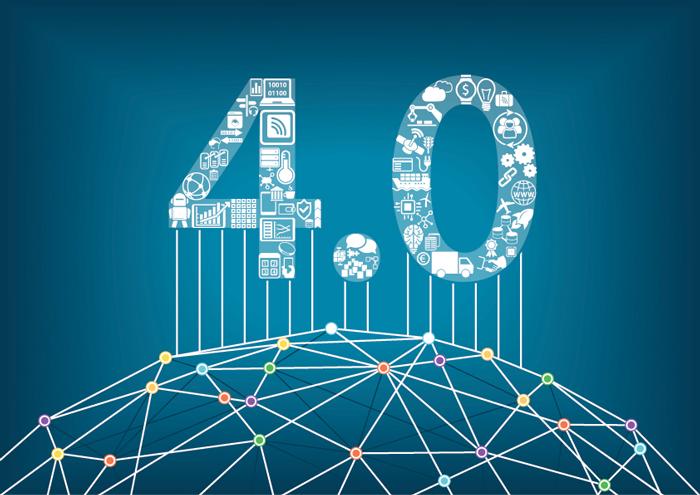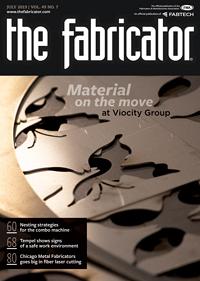Senior Editor
- FMA
- The Fabricator
- FABTECH
- Canadian Metalworking
Categories
- Additive Manufacturing
- Aluminum Welding
- Arc Welding
- Assembly and Joining
- Automation and Robotics
- Bending and Forming
- Consumables
- Cutting and Weld Prep
- Electric Vehicles
- En Español
- Finishing
- Hydroforming
- Laser Cutting
- Laser Welding
- Machining
- Manufacturing Software
- Materials Handling
- Metals/Materials
- Oxyfuel Cutting
- Plasma Cutting
- Power Tools
- Punching and Other Holemaking
- Roll Forming
- Safety
- Sawing
- Shearing
- Shop Management
- Testing and Measuring
- Tube and Pipe Fabrication
- Tube and Pipe Production
- Waterjet Cutting
Industry Directory
Webcasts
Podcasts
FAB 40
Advertise
Subscribe
Account Login
Search
What Industry 4.0 really means
A future where everyone, and everything, learns
- By Tim Heston
- July 13, 2019
- Article
- Manufacturing Software
Industry 4.0. We’ve all heard it as being about a world of smart machines and smarter factories. So what does Industry 4.0 mean to you? Several years ago I asked the question at various shops, and I usually got some variation of “It’s nice and everything, but I need to get these jobs out the door.” There’s a change in perception now, though, and that might be because we’re starting to see some elements of the Industry 4.0 picture become reality.
First, let’s back up. Industry 4.0 is just a term. Yes, it does refer to the fourth industrial revolution. The first was mechanization, the second was mass production, the third automation. Read articles about Industry 4.0 and you’ll learn about smart networks arranged in (as it says on top of the Industry 4.0 Wikipedia page) “cyber-physical systems.” Well, OK, that’s nice. But I’ve got to get jobs out the door.
The world of Industry 4.0 is a little like a painter with amazing colors (cyber-physical systems, artificial intelligence, cloud computing—choose your buzzword), yet has only a really small canvas to work with (the early technology adopters and platforms). Grow the canvas, and the colors really start to blend (more adopters mean more data, boosting system learning), and only then do you realize how amazing the resulting picture can be.
The size of the canvas matters. Not long ago the canvas was small, much of it an enhancement of predictive maintenance. If you connect a lot of machines and add the power of cloud computing, you can predict failures before they happen. You can also extract true machine uptime information (OEE) and put together some really effective analyses.
Connect that uptime and machine performance data to specific jobs or groups of jobs (like on a nest layout) and the information becomes even more useful. The machines really start to learn.
A laser cutting machine receives real-time feedback that tells it to slow its approach to a corner or over a rough surface. An automated part offloading system tries to lift a piece out of a nest, fails, tries again, and learns. This data feeds back to the cloud, which receives data from similar machines, which in turn helps develop better solutions: a better way to lift a part, a better way to cut around a sharp corner.
We’ve got some really interesting colors, but again, the canvas is small. Concepts like machine learning thrive on scale. Whenever you work with technology—like when you Google something or talk to Alexa—and the device seems eerily smart, that probably means the tech has been asked to do something similar millions of times before. But at least for now, we don’t have millions of laser cutting machines connected to the cloud and learning autonomously. That’ll happen only after the canvas grows.
Third-party companies specializing in data analytics are playing a role too—and it’s not just about connecting to machines. Consider Xometry. It started as a milling and 3D printing shop, and it’s now building a network of job shops, including sheet metal fabricators, that use its automated quoting engine. If a job shop qualifies for the network, it can use the quoting engine for free. And the larger the network grows, the smarter the quoting engine becomes.
Consider SendCutSend Inc., a sheet metal job shop in Reno, Nev., launched by software industry veteran Jim Belosic. Fresh out of the gate with a new fab shop, Belosic is already working on a vision system that could automate laser-cut part removal, even for the most reflective materials cut with narrow kerfs that are tough for many legacy vision systems to discern. What will make the automation smart enough to do this? The shop’s software relies on Amazon Web Services.
We might see more fabrication startups like this in the years to come, perhaps from entrepreneurs who can’t remember a time when they couldn’t access the world’s information from their phones. This, combined with efforts from machine tool providers and software and data analytics players, could make the canvas grow in ways we never expected.
What will Industry 4.0 allow fabricators to paint on a larger canvas? That will depend on the painter, of course, but you might think about the following picture. Some colors are already here, like automated quoting, nesting, and bend simulation. But as the technology scales up and the canvas grows, colors will have more room to blend to create vivid images with new hues—making everything a lot smarter.
The picture might start with automated quoting, drawing from shop floor and third-party data analytics. Upon acceptance, the job is scheduled and nested automatically, drawing data not only from the shop floor but from the cloud, be it provided by the machine toolmaker, a third party, or both.
Scheduling and nesting software could also draw from material- and material supplier-specific data; this would make it smart enough to know the implications of nesting long and skinny parts on a certain thickness and grade of a certain mill’s galvanneal that has a history of residual stress. So it would know to nest and microtab in such a way to prevent those long, skinny parts from bowing up after being cut and crashing the machine.
Parts are denested and sorted automatically—again, using data both from the local shop floor and from the cloud—then move on to forming, with bend simulations that consider individual operator preferences as well as the movement of workpieces between each step of a staged bend.
Once parts are formed, they move downstream immediately. Many jobs ship not in weeks or days but in a matter of hours. How can everything flow so smoothly? Because everything is connected, and everything is learning.
About the Author

Tim Heston
2135 Point Blvd
Elgin, IL 60123
815-381-1314
Tim Heston, The Fabricator's senior editor, has covered the metal fabrication industry since 1998, starting his career at the American Welding Society's Welding Journal. Since then he has covered the full range of metal fabrication processes, from stamping, bending, and cutting to grinding and polishing. He joined The Fabricator's staff in October 2007.
subscribe now

The Fabricator is North America's leading magazine for the metal forming and fabricating industry. The magazine delivers the news, technical articles, and case histories that enable fabricators to do their jobs more efficiently. The Fabricator has served the industry since 1970.
start your free subscription- Stay connected from anywhere

Easily access valuable industry resources now with full access to the digital edition of The Fabricator.

Easily access valuable industry resources now with full access to the digital edition of The Welder.

Easily access valuable industry resources now with full access to the digital edition of The Tube and Pipe Journal.
- Podcasting
- Podcast:
- The Fabricator Podcast
- Published:
- 04/16/2024
- Running Time:
- 63:29
In this episode of The Fabricator Podcast, Caleb Chamberlain, co-founder and CEO of OSH Cut, discusses his company’s...
- Trending Articles
AI, machine learning, and the future of metal fabrication

Employee ownership: The best way to ensure engagement

Steel industry reacts to Nucor’s new weekly published HRC price

Dynamic Metal blossoms with each passing year

Metal fabrication management: A guide for new supervisors

- Industry Events
16th Annual Safety Conference
- April 30 - May 1, 2024
- Elgin,
Pipe and Tube Conference
- May 21 - 22, 2024
- Omaha, NE
World-Class Roll Forming Workshop
- June 5 - 6, 2024
- Louisville, KY
Advanced Laser Application Workshop
- June 25 - 27, 2024
- Novi, MI



























